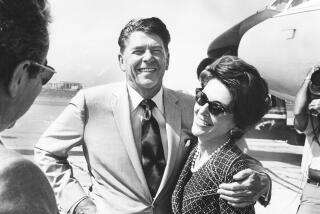Governor, Take Pat Brownâs Advice
Sacramento â Shortly after he was bounced from office, former Gov. Pat Brown wrote an advice letter to the bouncer, new Gov. Ronald Reagan.
âDear Governor,â Brown began.
âThereâs a passage in âWar and Peaceâ that every new governor with a big majority should tack on his office wall. In it, young Count Rostov, after weeks as the toast of elegant farewell parties, gallops off on his first cavalry charge and then finds real bullets snapping at his ears.
â âWhy, theyâre shooting at me,â â he says. â âMe, whom everyone loves.â â
âNothing worse will happen to you in the next four years. Learn to live with that, the rest is easy.â
Today, 38 years later, that counsel is just as timely for another celebrity governor, a superstar accustomed to basking in cheers, but now hearing jeers.
For the first time, real bullets are snapping at Gov. Arnold Schwarzeneggerâs ears. Theyâre being fired not just by his professional enemies -- Democrats and union leaders -- but by angry citizens, such as nurses, teachers and firefighters.
How Schwarzenegger handles the attacks -- whether he keeps his cool or explodes in a rage, whether he adjusts his tactics or stays stubbornly on course -- will largely determine his fate.
Learn to live with that. For this governor, that means to stop insulting his adversaries.
But this column is less about Schwarzenegger than Californiaâs 32nd governor, who died in 1996 at age 90. His 100th birthday will be celebrated Thursday with the opening of a Pat Brown exhibit at the state history museum, just south of the Capitol.
One item on display -- among the many photos, documents and memorabilia gleaned from the state archives -- will be Brownâs open letter to Reagan, which ran in the L.A. Times Sunday Magazine on Feb. 26, 1967.
âAs you must have noticed,â Brown continued, âthe press fires the first real bullets at new governors.... It is futile to fire back.... If you donât want it in the papers, donât do it.â
Pat Brown awareness has been rekindled by a well-written new biography, âCalifornia Rising: The Life and Times of Pat Brown,â by journalist Ethan Rarick, published by the University of California Press. The book has prompted several forums on the governor, who by any measure was one of Californiaâs greatest -- right up there with the reformer Hiram Johnson and the only three-termer, Earl Warren.
He was the first Democratic governor of the 20th century to be reelected to a second term, serving from 1959 to 1967.
âPat Brown was a visionary who helped turn California into a super state,â says Republican Bruce McPherson, the new secretary of state who will preside over opening ceremonies at the exhibit.
âHis legacy is in our civil rights, in the mighty state water project, in our roads and in our system of higher education. Itâs also in the story of the man himself, who worked tirelessly to make California a better place for future generations.â
That indeed is Brownâs legacy -- the legacy of a bold builder. For four decades, Californians have been living off his good public works: the largest state water project in the nation, an expanded university system with a master plan for higher education, 1,000 miles of new freeways.
âPat built the state,â says former Republican Assemblyman Bill Bagley of Marin County, a Brown tormentor at the time. âWe tormented him, then loved him.... From the standpoint of planning for growth, he was Californiaâs best governor.â
Rarickâs book also points out that besides being a builder, Brown sometimes was a bumbler. He occasionally failed as a political leader, most notably at the 1960 Democratic National Convention in L.A., when he lost control of the California delegation. He acquired the tag âtower of jellyâ by listening to his son Jerry -- a future governor -- and briefly sparing the life of âRed Light Banditâ Caryl Chessman. A vacillator, critics charged.
Brown was easy to poke fun at. In 1964, touring a deadly North Coast flood, he exclaimed: âThis is the worst disaster since I was elected governor.â
âI could never keep my mouth shut,â he candidly told a bunch of us at his 85th birthday party.
Through it all, Brown had the rare ability to laugh at himself with self-deprecating humor. âThe voters failed to appreciate my greatness,â he often said of his 1966 landslide loss to Reagan. Then heâd let loose a trademark belly laugh.
Brown made some colossal mistakes. But they mostly were mistakes of politics, not policy. They usually were born of commitment and courage. He spent every penny of his political capital.
Aggressively, astutely pushing the water project through the Legislature and stumping for its passage on the ballot cost him popularity in his native Northern California. But it allowed the south to keep growing and saved hundreds of northern lives from potential floods.
His fighting to end racial discrimination in housing angered voters, and Reagan capitalized on that in 1966. Brown lost the election, but was on the right side of history.
It wasnât the blundering that became his legacy. It was the bold deeds. This is the principal lesson to be learned from any study of Pat Brown. Errors can be excused. What counts for history is results.
To earn a legacy of greatness, a governor must do truly great deeds that directly affect people -- currently and in the future. Spend capital, but not on the frivolous.
Schwarzenegger should visit the exhibit, read the letter and buy the book.
George Skelton writes Monday and Thursday.
More to Read
Get the L.A. Times Politics newsletter
Deeply reported insights into legislation, politics and policy from Sacramento, Washington and beyond. In your inbox three times per week.
You may occasionally receive promotional content from the Los Angeles Times.











